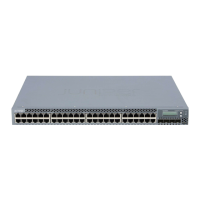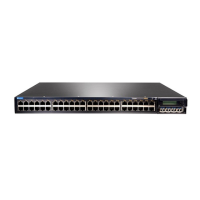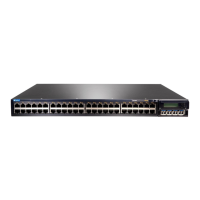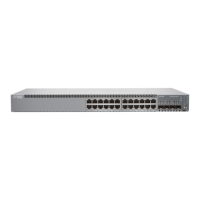•
Configuring Energy Efficient Ethernet on Interfaces (CLI Procedure) on page 93
•
Configuring Local Link Bias (CLI Procedure) on page 94
•
Configuring the Fields in the Algorithm Used To Hash LAG Bundle and ECMP Traffic
(CLI Procedure) on page 94
•
Configuring Tagged Aggregated Ethernet Interfaces on page 96
•
Configuring a Layer 3 Subinterface (CLI Procedure) on page 97
•
Configuring Unicast RPF (CLI Procedure) on page 97
•
Disabling Unicast RPF (CLI Procedure) on page 99
•
Configuring IP Directed Broadcast (CLI Procedure) on page 100
•
Tracing Operations of an Individual Router or Switch Interface on page 101
•
Tracing Operations of the Interface Process on page 101
Configuring Gigabit Ethernet Interfaces (CLI Procedure)
NOTE: This task uses Junos OS for EX Series switches with support for the
Enhanced Layer 2 Software (ELS) configuration style. If your switch runs
software that does not support ELS, see Configuring Gigabit Ethernet Interfaces
(CLI Procedure). For ELS details, see Getting Started with Enhanced Layer 2
Software.
An Ethernet interface must be configured for optimal performance in a high-traffic
network. EX Series switches include a factory default configuration that:
•
Enables all the network interfaces on the switch
•
Sets a default interface mode (access)
•
Sets default link settings
•
Specifies a logical unit (unit 0) and assigns it to family ethernet-switching (except on
EX8200 switches and Virtual Chassis)
•
Specifies Rapid Spanning Tree Protocol (RSTP) and Link Layer Discovery Protocol
(LLDP)
This topic describes:
•
Configuring VLAN Options and Interface Mode on page 32
•
Configuring the Link Settings on page 33
•
Configuring the IP Options on page 34
Configuring VLAN Options and Interface Mode
By default, when you boot a switch and use the factory default configuration, or when
you boot the switch and do not explicitly configure a port mode, all interfaces on the
switch are in access mode and accept only untagged packets from the VLAN named
default. You can optionally configure another VLAN and use that instead of default. You
Copyright © 2015, Juniper Networks, Inc.32
Network Interfaces for EX4300 Switches
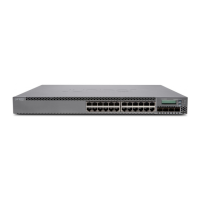
